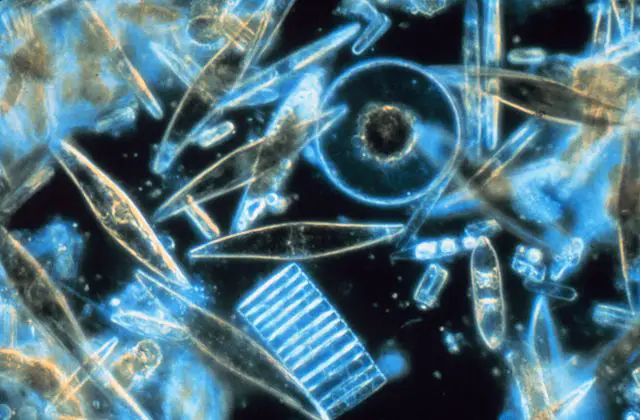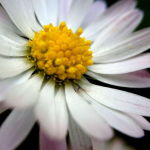Jonathan Dodd’s latest column. Guest opinion articles do not necessarily reflect the views of the publication. Ed
I can safely say that I have spent absolutely no time throughout my long and messy life thinking about phytoplankton. All that has changed since I went to the Café Scientifique talk last week on that very subject.
Dr Michelle Hale, from Portsmouth University enthralled an enthusiastic audience with tales of creatures that are too small to see (listen to her presentation). If you could line ten of these up side by side, they wouldn’t measure the thickness of a human hair. The only way to see what they look like is to paint them with gold (how?) and view them with a very special microscope.
It turns out that phytoplankton are the basic simple life-forms that exist right at the bottom of the food chain, and they exist in unimaginable numbers, everywhere. If you’re swimming anywhere in the oceans or lakes or rivers or even puddles, anywhere on the planet, you’ll find them. They get everywhere. They’re tricky little things, not quite plants and not quite animals. They start as single-celled things, which consist of the necessary items to survive and thrive, and some have managed to grow into little colonies. Mostly they contain some chlorophyll, and that’s why they need light.
That makes our air cleaner and safer
The only other thing they need, apparently, is stuff in the water, especially small amounts of carbon dioxide, nitrogen and phosphorus. They scoop them up, and the chlorophyll inside them uses the light in sunshine to convert those ingredients to sugar and oxygen. Just like plants on land. The only difference is that plants get their nutrients from the soil and the phytoplankton get them from the water around them.

Why should we care? Because they keep some of the carbon dioxide in their bodies, and when they die they sink down to the bottom of the ocean, taking it with them, and that makes our air cleaner and safer. They also make up the food for almost every other type of marine organism, and the organisms that feed on them, and so on, all the way up the food chain, right up to the giant whales. So no phytoplankton, no fish, and no life-forms that eat fish. I don’t think I’d like that.
It’s a natural negative feedback loop
Phytoplankton also produce a gas called DMS, or dimethyl sulphide, which helps those little drops of water up there in the atmosphere to freeze into ice crystals, which makes clouds. The beauty of this is that it regulates the clouds and the rainfall and the numbers of phytoplankton automatically. Like this. The sun shines over the ocean. The phytoplankton go mad and process lots of stuff in the water, producing DMS. Clouds form, there’s less sun over the ocean, the phytoplankton calm down. And so on. I like that. It’s a natural negative feedback loop.
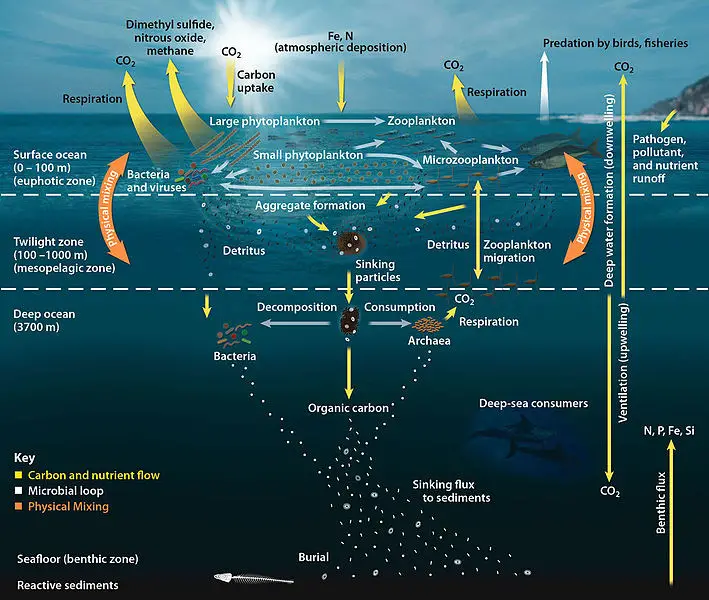
Whenever there’s a lot of phytoplankton food in the water, and light, the phytoplankton blooms, and species race in to gorge themselves, hence those amazing videos of fish and dolphins and whales and seabirds on The Blue Planet. They can get out of control occasionally, and turn the water red. And we mess up the system, with all the extra stuff washed into the sea from our factories and agriculture, our fertilisers and tiny plastic granules.
An area the size of Texas and Alaska combined
I’m a complete science no-starter, but every now and again something grabs my interest, or somebody gives me a lot of easy-to-digest information about a subject previously unknown to me, like this. I learned all this, more or less, directly from Dr Michelle’s talk, with a bit of help from Google search, and I hope I haven’t misunderstood or misrepresented the information she shared with us. The research that’s being carried out has two purposes. Firstly, it’s a subject that we knew hardly anything about, but we’re catching up. Secondly, we can now produce much better stats on changes in the environment. Apparently, the Arctic ice-cap has shrunk by about 50% since 1979, an area the size of Texas and Alaska combined.
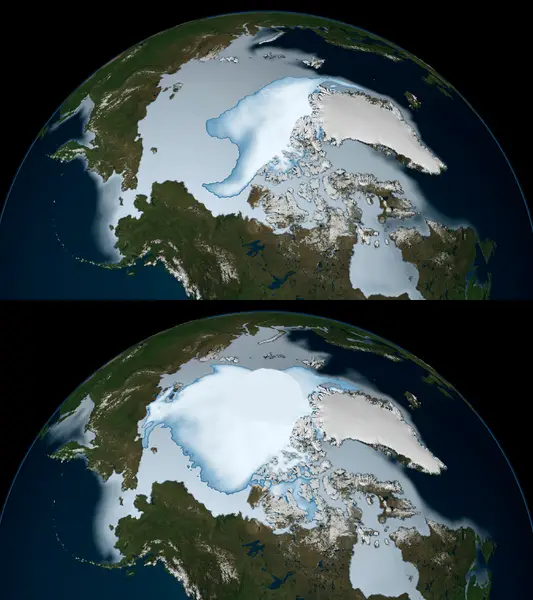
All this talk about these tiny things that swim around, invisible and minding their own business in unimaginable numbers made me start to wonder. If they’re everywhere, and often in the food we eat and the water we drink, whether they’re plants or animals, and whether a vegetarian should worry about it, or a Buddhist. I understand that a good Buddhist, particularly a monk, attempts to go through life without killing anything. I wonder how they square that with the accidental treading-on of ants, or the swallowing of phytoplankton while innocently drinking water. Let alone the extermination of Islamic Rohingya people in Myanmar.
The top half grows a new bottom
I also started wondering whether these tiny things are plants or creatures. They move around or swim in the top 100 metres of any body of water, but they’re usually heavier than water, so they’re always struggling to float upwards, before they sink below the line where there’s not enough light to survive. How do they know to do that? Apparently, some of them have developed small oil reservoirs that help them to float. But they make their own food using chlorophyll, which is a plant chemical. It’s all very confusing. And they don’t need their water to be cold or warm. They just don’t care. All they need is some sunlight.

The most interesting thing about them is how they reproduce. Apparently, at least some of them have a double method. First of all, if they get too big, they just split in two. The top half grows a new bottom, while the bottom grows a new top, but both are smaller than the original one. They can do this quickly, and many times in succession, thus vastly increasing their population, presumably, when there’s lots of food. But sooner or later, these much smaller examples can’t survive any more, so they create lots of eggs or sperm, which then get fertilised and grow into brand-new full-sized organisms. And so it goes.
In whichever scheme of things you believe you are living
And, finally, I started to wonder if all these innocent phytoplankton ever wonder what it’s all about. I started thinking about this literal soup of tiny organisms all chattering away, asking for the news or the gossip, wondering whether they should strive to be a good phytoplankton, or what happens to evil phytoplankton, and wondering if there’s a phytoplankton afterlife, after the big dark place down there which they’re destined to sink down to at the end of their lives, unless they get eaten in the meantime. I wonder if it’s an interesting life. And I remembered another favourite song, or at least half a song, by the Incredible String Band, which is actually about an amoeba, but it pretty much sums up my feelings about it all.
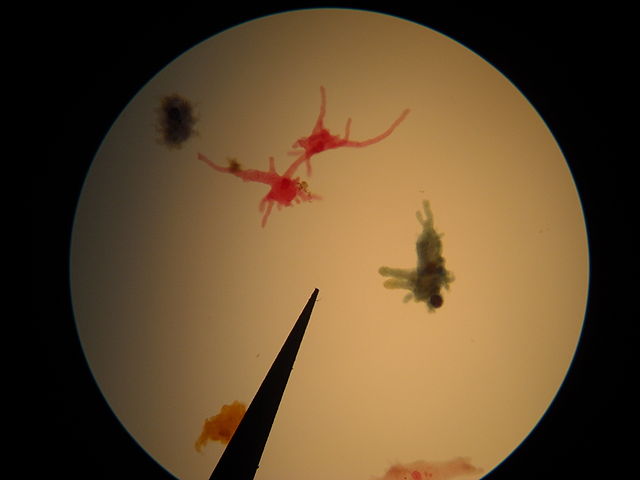
I’ll leave you with it, and may your life be as useful and productive, in whichever scheme of things you believe you are living.
If you have been, thank you for reading this.
Image: Public Domain
Image: Mike Baird under CC BY 2.0
Image: public domain
Image: Joey Comiso under CC BY 2.0
Image: NEON ja, colored by Richard Bartz under CC BY 2.0
Image: GreenBlueRed under CC BY 2.0

